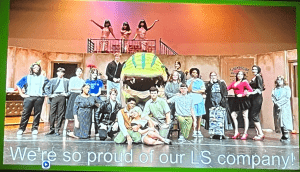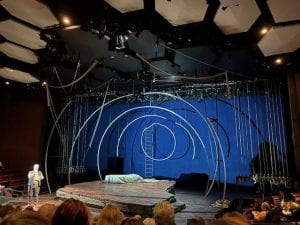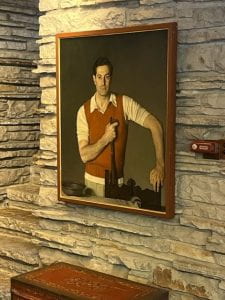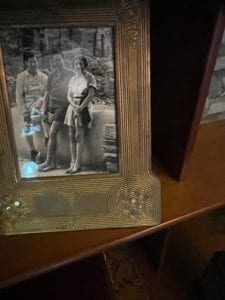
If you venture to the Women’s Eastern Reception, Diagnostic and Correctional Center for theater, go with faith that a company of incarcerated women can produce a comedy in high theatrical style. They are a delightful troupe of sisters having fun and bringing their audience along for the ride.
Britches, their latest performance, brings to life the story of Charlotte Cushman, the bold actor of the 19th century, who shocked and thrilled audiences with her portrayal of Romeo along with her sister’s Juliet. “When Queen Victoria saw Cushman as Romeo, she said she couldn’t believe it was a woman playing the part” (https://www.folger.edu/podcasts/shakespeare-unlimited/romeo-charlotte-cushman/).

The play Britches invents a love triangle of Charlotte (Dylan Staudette), her sister Susan (Natasha White), and the understudy Joan (Tessa Van Vlerah), as their company makes a comedy of performing the tragedy Romeo and Juliet, complete with a dark figure who threatens to upset the joie de vivre of the play. In Britches the actors, including Wanda, the nurse (Patty Prewitt), perform the famous tragedy in rehearsal, then at an evening show, then at an intoxicated cast party, then at the matinee the next day, then with a final celebration.
Six “Scholars” (Tara Carroll, Natasha Orender, Sandra Dallas,Kylie Shepherd, Angaline Ryan, Marie Pursley) cross the stage at convenient intervals to explain the customs and motives of the comedy, adding context and humor. A black-cat-costumed actor (Yvette Mahan) crosses the stage occasionally or settles down at stage center to interrupt the flow of action as only a cat can. The random interruptions add insight and lightness to the dialogue of the acting troupe as they prepare, perform and then reflect on their rendition of the play.

“I asked them to add their insight to this ‘Lady Romeo’s’ story. Incarcerated people who reside in a women’s facility are no strangers to playing male Shakespeare roles; in fact they may be the greatest experts on this performance practice in today’s theatrical ecosystem.”
Her instincts proved exactly right. The brassy playfulness of the women is perfectly attuned to the boldness of Cushman’s renditions of protagonists such as Hamlet, Romeo and Lady Macbeth, which delighted nineteenth century theater-goers from Boston to the British Isles. In Britches Cushman performs her most famous role as Romeo opposite her sister’s Juliet. “This bold choice further solidified her reputation as a groundbreaking actress willing to break down barriers in the pursuit of artistic excellence” (program notes).
The play celebrates the joy of an acting company first in its rehearsal, when Juliet balks at climbing the lofty stepladder to her balcony, then in the after-party of the evening performance, when a massive black cauldron is rolled out with the traditional fare of actors–beans and rice. They celebrate their modest provisions with a rousing musical tribute to “Beans and Rice,” reminiscent of a drinking song in a local pub. In the finale, the company reprises their tribute to Beans and Rice.
The play was directed by Prison Performing Arts’ own Artistic Director, Rachel Tibbets, assisted by Costume Designer Liz Henning and Set Designer Erik Kuhn.
Britches gave its only two performances on Thursday, March 14. The next Prison Performing Arts production will be 12 Angry Men, at the Northeast Correctional Center. See the PPA website for more information: https://www.prisonperformingarts.org/about-ppa.
Prison Performing Arts, the facilitator for performances like Britches, “nurtures the discipline, teamwork, and communication skills necessary for successful re-entry into society.” PPA also works in the Missouri Eastern Correctional Center, the Northeast Correctional Center, the St. Louis City Juvenile Detention Center, the Transition Center of St. Louis, the Hogan Street Regional Youth Center, and the Division of Probation & Parole – District 17.
Donations may be sent to:
Prison Performing Arts
3333 Washington Ave.
Ste. 203-B
St. Louis, MO 63103
r



 What about the latest rendition, just finishing a run in the Cincinnati suburb of Finneytown? This version offers more of the sinister take-over of Audrey, but her offspring appear as the familiar main characters sporting the flowery coronas around their heads. Everyone seems delighted with the absurd invasion of Audrey’s descendants.
What about the latest rendition, just finishing a run in the Cincinnati suburb of Finneytown? This version offers more of the sinister take-over of Audrey, but her offspring appear as the familiar main characters sporting the flowery coronas around their heads. Everyone seems delighted with the absurd invasion of Audrey’s descendants.

 skid row, featuring the expected signs advertising Pay-day loans, Adult bookstores, and MassageParlors. In the very middle is the innocent “Little Shop,” a flower shop that is failing in the engulfing neighborhood. As the musical progresses signs of success pop up on the flanks of the set advertising “Audrey II” the exotic, yet ominous plant that draws customers to the little shop. The signs testify to the internal materialist compromises in the shop. The media are invited in to tell the rags to riches story and make the Little Shop famous. They tell a clearly contrived tale of success.
skid row, featuring the expected signs advertising Pay-day loans, Adult bookstores, and MassageParlors. In the very middle is the innocent “Little Shop,” a flower shop that is failing in the engulfing neighborhood. As the musical progresses signs of success pop up on the flanks of the set advertising “Audrey II” the exotic, yet ominous plant that draws customers to the little shop. The signs testify to the internal materialist compromises in the shop. The media are invited in to tell the rags to riches story and make the Little Shop famous. They tell a clearly contrived tale of success.










